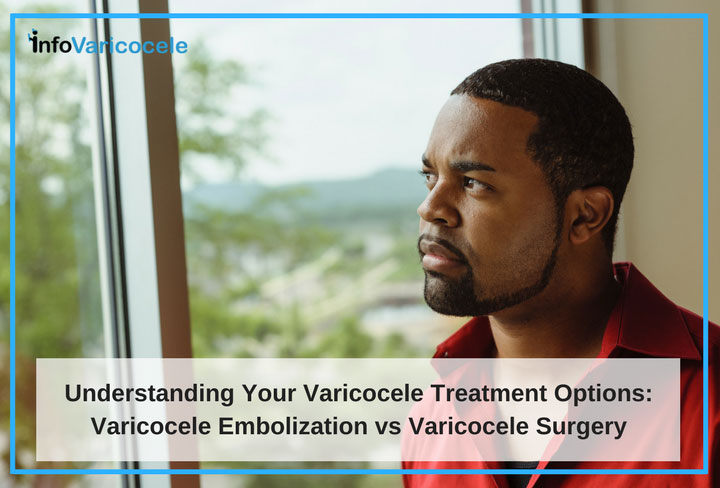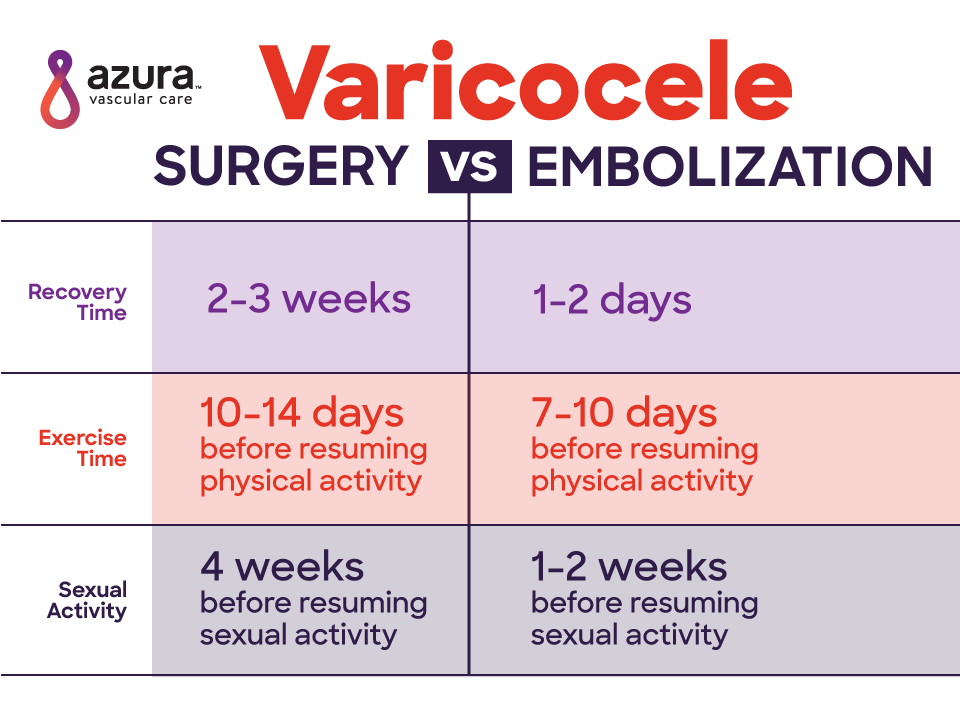
Today, men suffering from varicoceles have options when considering treatment. Previously, surgery was the only way you could treat these varicose veins of the scrotum. Recent medical advances have allowed men to choose between surgical treatment and embolization, a minimally invasive alternative to surgery. It’s important to understand the advantages and disadvantages of varicocele embolization vs surgery before making a final decision.
What Are My Treatment Options?
There are two types of treatments for varicoceles: surgery and a minimally invasive procedure called embolization.
Surgical Options:
There are 3 surgical options that are used to treat varicoceles.
- Open Surgery — a surgeon makes an incision into either the upper scrotum, the groin, or the lower abdomen, finds the veins, and ties them off so blood can’t flow through them. Open surgery requires either general or local anesthesia.i
- Microsurgery— a complex surgery performed using a microscope. The surgeon can more easily identify the exact veins. While the procedure is more complex, it has less complications and a lower recurrence rate than the open surgical approach.
- Laparoscopic — the surgery is performed through small incisions and uses specific surgical instruments to see inside the body and make the repairs. The laparoscopic method has an increased chance of complications and requires general anesthesia.
RELATED: Your Guide to Understanding Everything About Varicocele Surgery
Minimally Invasive Embolization Option:
Varicocele embolization is a minimally invasive outpatient procedure that only requires local anesthesia.
- An interventional radiologist makes a small nick in the skin.
- A small catheter is threaded through the skin nick into a vein, usually in the groin or neck.
- Using x-rays imaging as guidance, the catheter is advanced into the abdomen and into the varicose vein.
- The vein is intentionally closed off with small metal coils and a sclerosant, a special medication used to close off veins. Blood flow to the damaged veins is blocked allowing healthy veins to take over, restoring normal blood flow.ii
Comparing Surgery with Embolization
There are many differences between the surgical and minimally invasive options. Read on for a break down of the implications, benefits, and concerns that go along with each treatment.

Anesthesia and Sedation:
- Open surgery and the microsurgical technique — can both be performed under general or local anesthesia.
- Laparoscopic surgery — requires general anesthesia.
- Embolization — needs only local anesthesia and mild sedation, if you want it.
Hospital Stay:
- Surgery — it’s not uncommon for surgical recovery to require an overnight stay in the hospital.iii
- Embolization — can be performed as an outpatient procedure.iv
Recovery Time:
- Surgery — recovery time is 2-3 weeks.
- Embolization — recovery time is 1-2 days.
Success Rate:
- Surgery — one out of 10 men have a post-surgery recurrence of a varicocele. However, most studies show that microsurgical offers the best overall treatment within the surgical options.v
- Embolization — procedures have a 90% long-term success rate.
Scarring:
- Surgery — will leave some scarring, as you’ll have incisions and sutures.
- Embolization — does not require cutting, so there are no long-term scars.
Exercise Time:
- Surgery — you should wait 10 – 14 days before resuming physical activity.
- Embolization — it’s recommended you wait to exercise 7 – 10 days.
Sexual Activity:
- Surgery — if you have surgery, you’ll be advised to not engage in sexual activity for 4 weeks.
- Embolization — if you opt for varicocele embolization, you may resume normal sexual activity in 1-2 weeks.
***Note that it will take about 3 months to detect any improved changes in sperm count after either surgery or embolization.
RELATED: How Long Do I Have to Wait to Have Sex After Treatment for a Varicocele?
Risks of Surgery & Embolization
As with any medical procedure, there are risks to be aware of.
Surgical Risks:
- Testicular atrophy
- Infection
- Damage to an artery
- Varicoceles recurrencevi
Embolization Risks:
- Minor complications
- Temporary pain in the flank area
- An arterial puncture
- A migration of embolizing materialsvii
- Slight risk of infection
The Benefits of Getting Treatment
Regardless of which option you choose, varicocele embolization or surgery, treating your varicoceles can greatly alleviate your pain and discomfort. Long lasting benefits of treatment include testicles returning to a normal size, increased sperm count, better quality of sperm, better DNA quality in sperm, and a better chance at achieving pregnancy. Other benefits include normalizing testosterone levels.viii
Men who previously thought there was no hope of correcting this problem, reducing pain, or creating a family now have viable choices. Technological advances have provided ways to avoid a surgical procedure while achieving similar results. If diagnosed with a varicocele, embolization is a good alternative for the right candidate. Before you make your decision, read more about “What is Varicocele Surgery” and “What is Varicocele Embolization” If surgery has been recommended, you may want to consider speaking with a varicocele embolization specialist for a second opinion.
Sources:
ihttp://www.mayoclinic.org/diseases-conditions/varicocele/basics/treatment/con-20024164
iihttp://www.mayoclinic.org/diseases-conditions/varicocele/basics/treatment/con-20024164
iiihttp://www.sirweb.org/news/newsPDF/facts/Male_Infertility-Varicoceles_fact_sheet.pdf
ivhttp://www.mayoclinic.org/diseases-conditions/varicocele/basics/treatment/con-20024164
vhttps://www.cornellurology.com/clinical-conditions/male-infertility/general-information/varicocele/
vihttp://www.mayoclinic.org/diseases-conditions/varicocele/basics/treatment/con-20024164
viihttp://www.ncbi.nlm.nih.gov/pmc/articles/PMC3114590/
viiihttps://my.clevelandclinic.org/health/diseases_conditions/hic-varicocele


